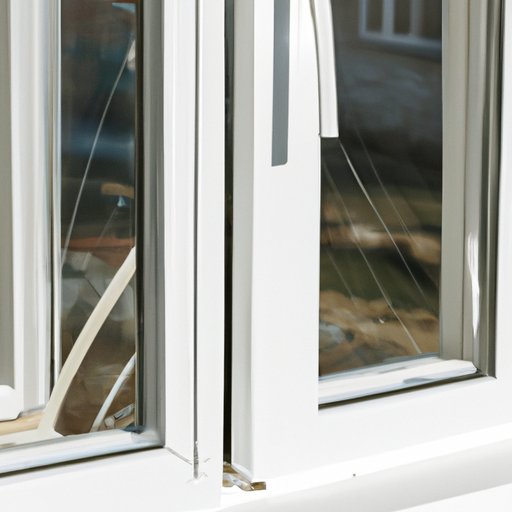
Introduction
Replacing windows is an important aspect of home improvement, but it can be an intimidating process. Learning how to replace windows yourself can help you save money and upgrade your home’s energy efficiency. In this article, we’ll walk you through the process of window replacement step-by-step, comparing different types of windows, and discussing common window problems and solutions.
Step-by-Step Instructional Guide
Before starting the project, you’ll need some necessary materials and tools. The materials you may need include the new window, exterior caulk, and insulation strips. The tools you will require include a pry bar, hammer, utility knife, caulking gun, putty knife, drill, and screws. After gathering your materials and tools, it’s important to take accurate measurements before commencing with the project. Proper measurements will ensure your new window fits correctly and ensure your new window will be sealed correctly.
Step one: remove the old window by taking off the trim, making the necessary cuts to the caulk and breaking the sash free. Step two: Prepare the new window for installation by placing it in the rough opening and leveling it. Step three: Install the new window using screws and insulation strips, using caulk to seal areas that require sealing. Step four: replace the trim in the interior window and exterior window trim in a way that looks great and is practical. Don’t forget to insulate and caulk along with the edges of the new window post-installation.
For post-installation, maintenance ensure that the window is functioning effectively and is not letting air in, clean it regularly, and check it physically.
Comparison of Replacement Windows
There are many different types of replacement windows to consider for your home. Some of the most popular options include wood, vinyl, fiberglass, and aluminum windows. For each type of window, there are pros and cons to consider.
Wood windows are visually attractive, but they require maintenance and are less energy-efficient than other options. Vinyl windows are cost-effective, require little maintenance, and are energy-efficient, but they can be limiting in terms of style. Fiberglass windows are durable and energy-efficient, and they can mimic the look of wood without the maintenance required by wood windows. Aluminum windows are often the best options for extreme weather conditions, as they are durable and long-lasting, but they are not as energy-efficient as other options.
When deciding which type of replacement window to choose, consider your specific needs and preferences, and factor in cost as well.
Energy-Efficient Windows
Energy-efficient windows are an essential consideration in the modern home. Not only do they help reduce energy consumption, but they also assist in lowering utility bills and help you save money in the long run. When searching for energy-efficient windows, look for those that have a low U-factor and a low Solar Heat Gain Coefficient (SHGC) rating. The U-factor measures the rate of heat loss through the window, while the SHGC rating measures the percentage of solar heat that is transmitted through the window.
Additionally, consider windows with multiple panes, low-E coatings, and gas fills for maximum energy efficiency.
Common Window Problems
Windows are known to have issues. If you have drafts, leaks, or foggy windows, you may wonder how to approach these problems. Common causes of these issues include poor sealing, failed window seals, and water damage.
There are some measures to take to troubleshoot your window. One thing you can do is to re-caulk your window or have someone do this for you. Another action is checking the weather-stripping to ensure it’s not worn or damaged and then replacing or fixing it when found. If these don’t solve the issues, consider contacting a professional for assistance. It may also be necessary to replace your windows altogether, especially if they are old and outdated.
DIY vs. Hiring Professionals
One significant consideration when thinking about replacing your windows is whether you should handle the project on your own or hire a professional. Doing the project yourself can save you money but ensure that you have the necessary knowledge and tools to complete the project. DIY window installations could also pose some risk to your safety if you don’t have the experience. Hiring a professional helps ensure that the project is done correctly and lessens your risk of potential injury.
If you decide to do the project yourself, ensure that you have all the equipment and tools required to handle it effectively, or you might end up making it worse.
Conclusion
Replacing windows can be an inexpensive and effective way to upgrade your home and increase energy efficiency. Knowing how to replace windows yourself can help you save money and create a beautiful finished product. Remember to take accurate measurements, compare different window options, and consider energy efficiency. Don’t hesitate to seek the help of a professional if necessary, and proceed with confidence, knowing that you have the knowledge necessary to tackle this project successfully.





